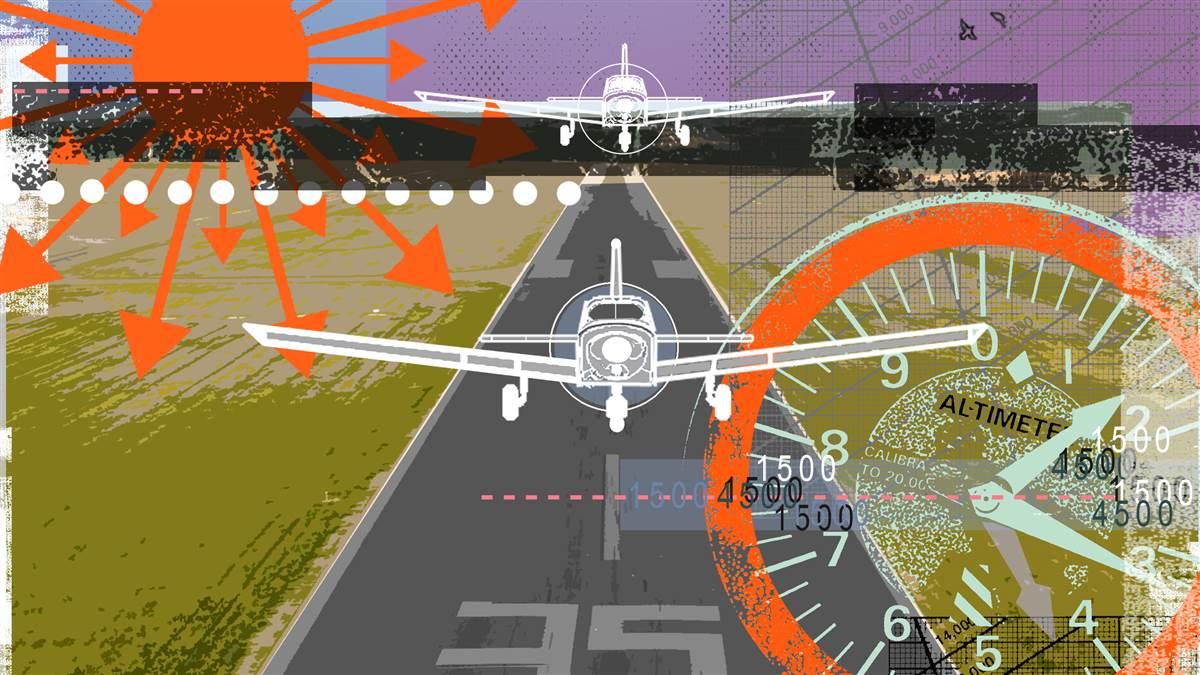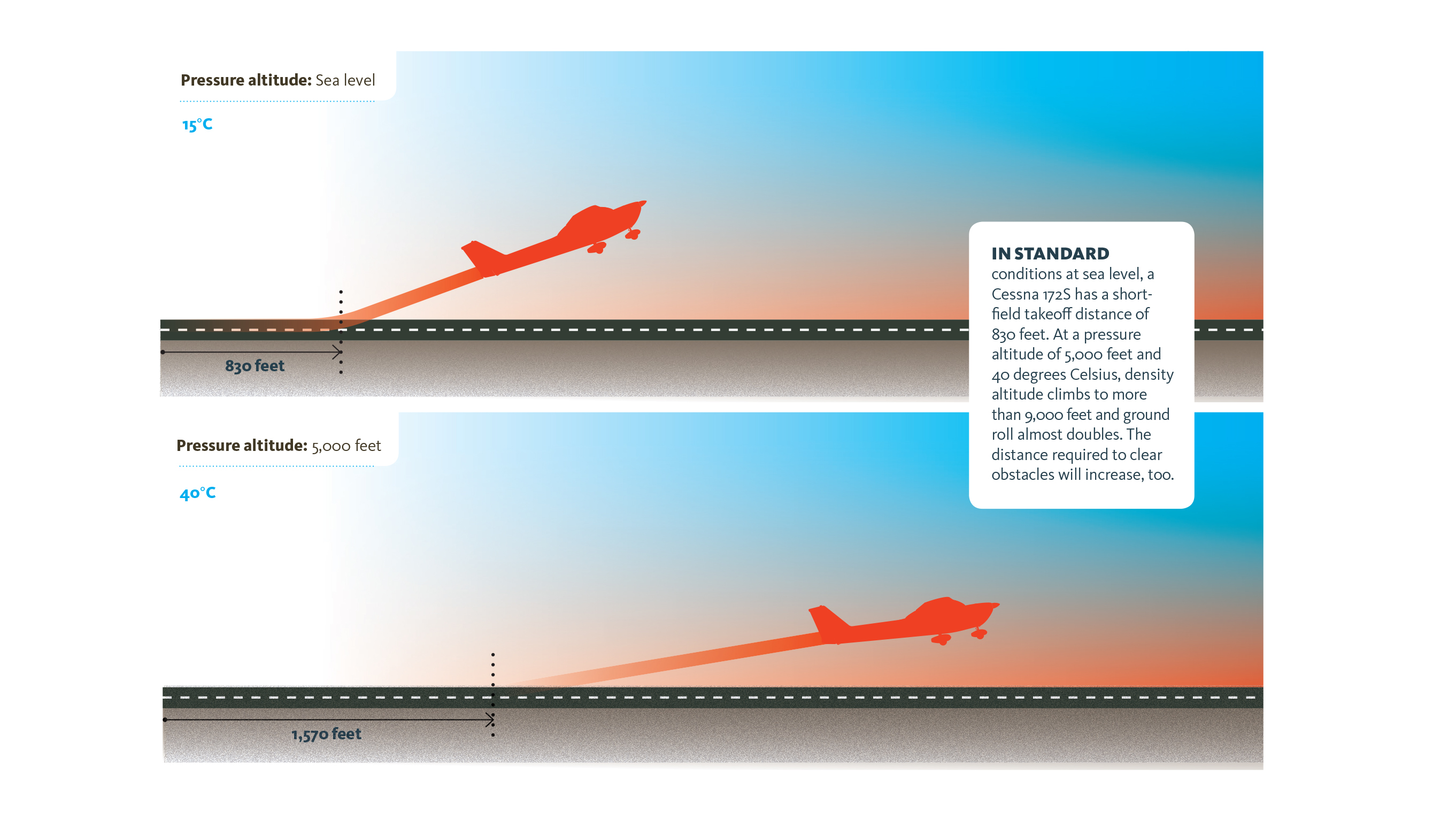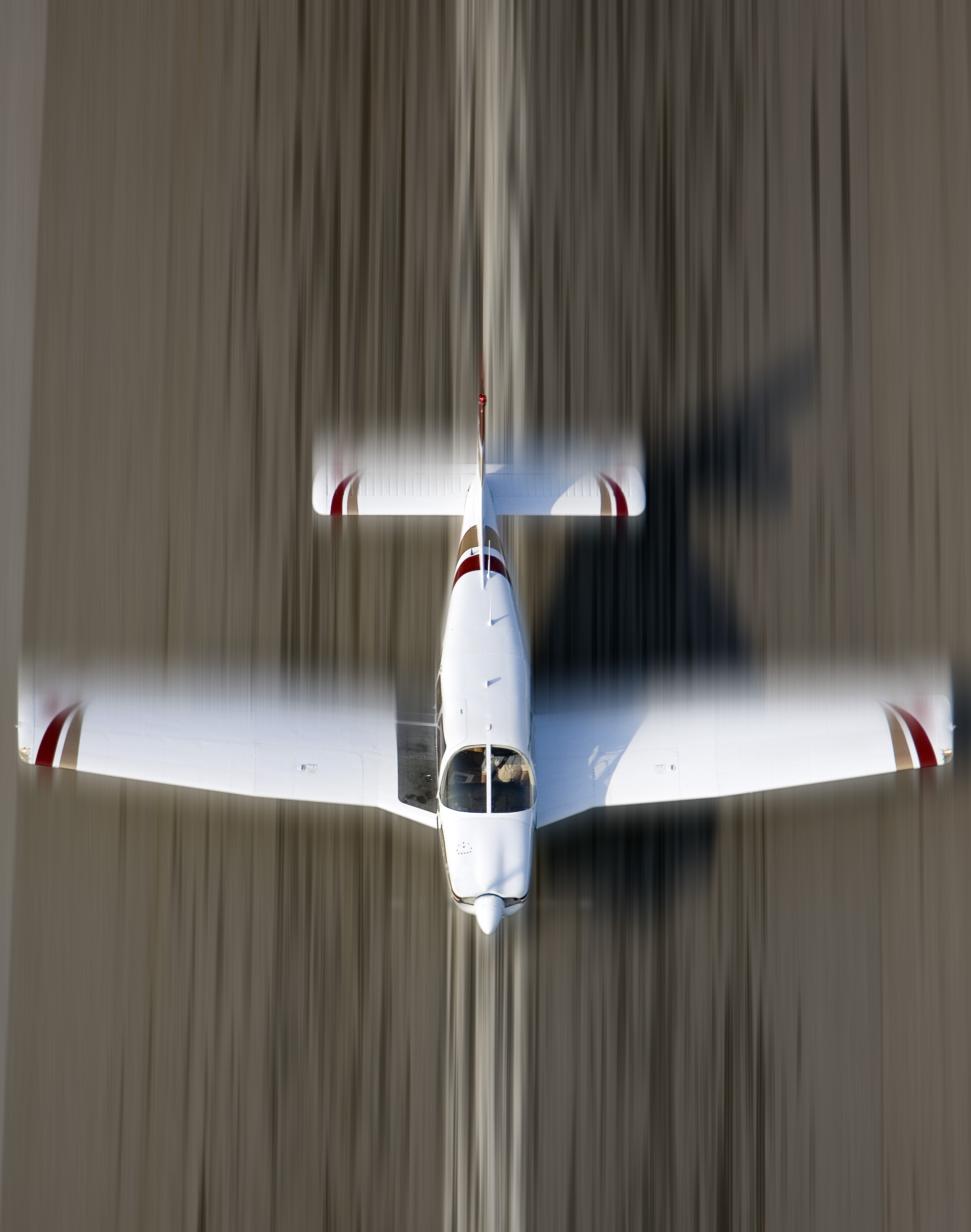Into Thin Air
What density altitude really means

Illustration by Sarah Jones
What happened? You’ve visited this airport several times before, and always were off the ground in less than 1,000 feet.
The perspiration is a clue. Other visits had been during the spring and fall, on comfortably cool days. This one is during the summer. The outside air temperature is 98 degrees Fahrenheit, and you had not compensated for the increased density altitude—the field elevation is a modest 1,480 feet, but to the airplane, the effective altitude is 4,577 feet.
Many concepts in aviation can be learned from a book or ground school, but some are learned better by experiencing them. Density altitude is one of those. You probably could recite a definition of density altitude, but until this scorching summer day in Herington, Kansas, you may never have truly experienced it.
Density altitude is pressure altitude corrected for variations from standard temperature. When conditions are standard, pressure altitude and density altitude are the same. When the temperature climbs above standard, however, the density altitude rises. Why is this important? Because it’s directly related to the performance of your aircraft.
Lori MacNichol is the president and owner of McCall Mountain Canyon Flying Seminars LLC, located at McCall Municipal Airport in McCall, Idaho. Her business offers individual instruction and seminars in backcountry flying. The airport elevation is 5,024 feet and many of Idaho’s backcountry airports are even higher, so density altitude comprises a large part of the curriculum.
Most of MacNichol’s first-time customers’ knowledge of density altitude is pretty weak, she said. “They understand performance charts—they get that. And they understand how the ground roll increases. But what they really don’t understand is how thin the air can become, and how reduced their horsepower can become.”
As altitude increases, the air’s density decreases. Temperatures higher than standard also decrease air density. The thin air at high density altitudes reduces lift, because it exerts less force on your wings; reduces engine power, because there’s less air to mix with the fuel; and reduces thrust, because the propeller—also an airfoil, just like the wings—is less efficient in thin air. Combined, these result in longer takeoff and landing rolls, decreased climb performance, and a reduction—often significant—in engine performance.
Regardless of the actual altitude at which an aircraft is flying, it will perform as though it is operating at the existing density altitude—which can be thousands of feet higher than the altitude indicated on the altimeter. (Air density also is affected by humidity, but humidity’s effect on density altitude is much less dramatic.)
“When we look at how your engine is robbed—when it’s 230 horsepower at sea level and you take it to 7,000 feet [density altitude], and realize that it’s just 180 horses—they go, ‘Wow. I’m not going to be able to put four people and gas in there,’” MacNichol said.
Another way to look at density altitude’s performance-robbing ability is to calculate the amount of excess horsepower available for climbing. Take a 200-horsepower Cessna Cardinal RG, calculated at sea level to require 122 horsepower to maintain level flight at VY—meaning there are 78 excess horses available for climb. At a density altitude of 8,400 feet, that excess horsepower has fallen to 18.

“It’s really easy in a Cessna 172 to have just 18 horses left for climb,” MacNichol explained. “Hey, if you can accept a 108-feet-per-minute rate of climb, more power to you. But if you get into a downdraft or a little turbulence, you can be settling and clawing for altitude.”
In a case like this it can really help to shuttle out your passengers, taking off with two people instead of four.
Unfortunately, in the high-elevation, mountainous area where MacNichol flies, density altitude doesn’t receive enough respect from pilots. “When I look at all the NTSB reports annually for this region, pretty much all those accidents and incidents circle back to a density altitude issue.”
The experience level of MacNichol’s first-time customers can vary widely. She prefers customers to have a minimum of 250 hours, with at least 50 in the make and model of aircraft they’re bringing. One recent client had 230 hours. “And then I get people who have 12,000 hours. It’s all over the board,” said MacNichol, who will make exceptions after talking with a prospective customer. “It’s all about helping people who are gung ho and ready to go.”
They all should leave with a practical knowledge of density altitude, one that goes far beyond a ground-school definition.
“I always try to emphasize, try not to be surprised by your lack of power reserves for climb,” she said. “Good performance charts—and not all are—can help to alert you. And remember that your airplane isn’t new, and its cylinders might not have the highest compression values—in which case you’re already starting at a disadvantage.”
MacNichol cautions against what she calls the density altitude brain-fade takeoff. “You don’t necessarily have to be in the mountains. The key is to know your ground rolls. What’s important is you have to have some parameters pre-decided for takeoff. It’s almost like a safety briefing. At a backcountry airport we’re going to have a target spot for liftoff—maybe a bush beside the runway, before the halfway point. If I don’t lift off, or don’t have 70 percent of my rotate speed at that bush, I’m going to have to abort my takeoff and figure out what’s wrong—instead of pressing on. A lot of pilots don’t think about that.”
Some pilots think more about the landing than the takeoff. If a takeoff is aborted, what went wrong? Did you lean the mixture correctly? Was density altitude calculated correctly?
In density altitude scenarios, most pilots will follow the POH procedure for a short-field takeoff—but many of those procedures don’t say when to retract the recommended flaps. Always wait until you’re well clear of any obstacles or obstructions. “I catch people trying to get rid of their flaps before they clear the trees. You don’t want to do that,” she said. Retract the flaps gradually.
And small changes in technique can bring big benefits to landings under high density altitude conditions.
“When the air is thin, with real density altitude, pilots couldn’t believe how small of a pitch change causes the airspeed to just drop off. You’re all of a sudden five knots off. A steeper stabilized approach helps to offset some of the density altitude issues,” she said. For example, a pilot will use more power to maintain a typical 3-degree glidepath, and would need a lot of power—power that might not be available—to arrest a sink. The difference between a 500- to 600-foot-per-minute descent, instead of 400 to 500 fpm, “makes an incredible difference in a density altitude situation.”
MacNichol believes most people understand the leaning procedures recommended for takeoffs in high density altitude conditions—if they remember to lean. But proper airspeed isn’t stressed enough, she said. “Indicated airspeed is indicated airspeed. We fly indicated airspeed no matter what our density altitude is. That’s not emphasized enough.” Yes, in the thin air, groundspeed will be higher. “That doesn’t mean you need to fly slower,” she said.
So what happened at the beginning of the story? You taxi back to the ramp and review the pilot’s operating handbook—and realized that you had not leaned the engine for efficient operation at the high density altitude. On the next try the runway lights seem to whiz by faster and the rate of climb still is unusually low—but you lift off before the runway’s midpoint, and eventually climb into some (relatively) cooler air. You also have a newfound appreciation for what the phrase density altitude really means.
Learn more about density altitude
While the AOPA Air Safety Institute’s popular Mountain Flying online course offers a great introduction to the special skills required for mountain flying, it’s also infused with information about high density altitude operations. Also review the Air Safety Institute’s Mountain Flying Safety Advisor, which begins with a section on density altitude.
Rules of thumb for high flying
At McCall Mountain Canyon Flying Seminars, Lori MacNichol teaches rules of thumb to help pilots quickly assess conditions:
• To determine density altitude at a given pressure altitude, add 600 feet to the existing pressure altitude for every 10 degrees Fahrenheit above standard temperature for that altitude. (At MacNichol's 5,000-foot airport, standard temperature is 41.5 degrees F.)
• A normally aspirated aircraft engine will lose approximately 3.5 percent of its horsepower for every 1,000-foot increase in density altitude. So at a density altitude of 7,000 feet, 25 percent of engine power has vanished.
• A 10-percent increase in aircraft gross weight will increase takeoff distance by 20 percent.




